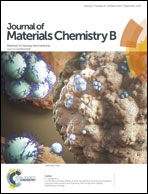Co-delivery of doxorubicin and P-glycoprotein siRNA by multifunctional triblock copolymers for enhanced anticancer efficacy in breast cancer cells†
Abstract
Combined treatment of chemotherapeutics and small interfering RNAs (siRNAs) is a promising therapy strategy for breast carcinoma via their synergetic effects. In this study, to improve the therapeutic effect of doxorubicin (DOX), novel triblock copolymers, folate/methoxy-poly(ethylene glycol)-block-poly(L-glutamate-hydrazide)-block-poly(N,N-dimethylaminopropyl methacrylamide) (FA/m-PEG-b-P(LG-Hyd)-b-PDMAPMA), were synthesized and used as a vehicle for the co-delivery of DOX and P-glycoprotein (P-gp) siRNA into breast cancer cells. The triblock copolymers were synthesized by a combination of ring-opening polymerization of γ-benzyl-L-glutamate-N-carboxyanhydride using cystamine-terminated heterotelechelic PEG derivatives possessing folate or methoxy end groups (FA/m-PEG-Cys) as initiators and reversible addition–fragmentation chain transfer polymerization of N,N-dimethylaminopropyl methacrylamide followed by hydrazinolysis. The successful synthesis of the copolymers was confirmed by 1H NMR and gel permeation chromatography. DOX was covalently conjugated onto the poly(L-glutamate-hydrazide) blocks via a pH-labile hydrazone linkage, and the DOX-conjugated triblock copolymers could self-assemble into nanoparticles in aqueous solutions. P-glycoprotein (P-gp) siRNA was then bound to the cationic poly(N,N-dimethylaminopropyl methacrylamide) (PDMAPMA) blocks through an electrostatic interaction, resulting in the formation of spherical nanocomplexes with an average diameter of 196.8 nm and a zeta potential of +28.3 mV. The in vitro release behaviors of DOX and siRNA from the nanocomplexes were pH- and reduction-dependent, and the release rates were much faster under a reductive acidic condition (pH 5.0, glutathione: 10 mM) simulating the intracellular endo-lysosomal environment of cancer cells compared to physiological conditions. The fast payload release rates were closely related to both the glutathione-triggered detachment of PEG blocks from the nanocomplex surface and the pH-sensitive cleavage of hydrazone linkages. FA-decorated nanocomplexes showed higher cellular uptake efficiency and cytotoxicity against MCF-7 cells than FA-free nanocomplexes, as confirmed by confocal laser scanning microscopy, transmission electron microscopy, MTT and flow cytometry analyses. Our results demonstrated that the multifunctional triblock copolymer-mediated co-delivery of DOX and P-gp siRNA might be a new promising therapeutic strategy for breast cancer treatment.


 Please wait while we load your content...
Please wait while we load your content...